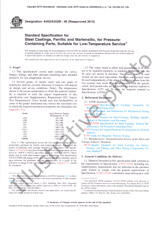We need your consent to use the individual data so that you can see information about your interests, among other things. Click "OK" to give your consent.
ASTM D6653/D6653M-13(2021)
Standard Test Methods for Determining the Effects of High Altitude on Packaging Systems by Vacuum Method
Translate name
STANDARD published on 1.10.2021
The information about the standard:
Designation standards: ASTM D6653/D6653M-13(2021)
Publication date standards: 1.10.2021
SKU: NS-1042206
The number of pages: 4
Approximate weight : 12 g (0.03 lbs)
Country: American technical standard
Category: Technical standards ASTM
The category - similar standards:
Environmental testingOther standards related to freight distribution of goods
Annotation of standard text ASTM D6653/D6653M-13(2021) :
Keywords:
air shipment, feeder aircraft, high altitude, packaging, vacuum testing,, ICS Number Code 19.040 (Environmental testing),55.180.99 (Other standards related to freight distribution of goods)
Additional information
| Significance and Use | ||||||||||||||||
|
4.1?Packaged products transported by meansn of the feeder aircraft network are liable to experience altitudes as high as 5 791 m [19 000 ft].4 When exposed to these high altitude conditions, products or packaging systems, or a combination thereof, may be affected negatively by the resultant pressure differential. 4.2?These test methods are suitable for evaluating the effect of high altitude on packaging systems. 4.3?These test methods are suitable for package or product, or both, development and engineering. 4.4?Other test methods, such as Test Methods D3078, D4991 and D5094, test for leakage of packaging systems by vacuum method and are applicable for testing the effects of high altitude. |
||||||||||||||||
| 1. Scope | ||||||||||||||||
|
1.1?These test methods determine the effects of pressure differential when packaged products are transported by meansn of certain modes of transport, such as feeder aircraft or ground over high mountain passes. The results of these tests are intended to be used for qualitative purposes. 1.2?The values stated in either SI units or inch-pound units are to be regarded separately as standard. The values stated in each system may not be exact equivalents; therefore, each system shall be used independently of the other. Combining values from the two systems may result in non-conformance with the standard. 1.3?This standard does not purport to address all of the safety concerns, if any, associated with its use. It is the responsibility of the user of this standard to establish appropriate safety, health, and environmental practices and determine the applicability of regulatory limitations prior to use. 1.4?This international standard was developed in accordance with internationally recognized principles on standardization established in the Decision on Principles for the Development of International Standards, Guides and Recommendations issued by the World Trade Organization Technical Barriers to Trade (TBT) Committee. |
||||||||||||||||
| 2. Referenced Documents | ||||||||||||||||
|
We recommend:
Technical standards updating
Do you want to make sure you use only the valid technical standards?
We can offer you a solution which will provide you a monthly overview concerning the updating of standards which you use.
Would you like to know more? Look at this page.




 Cookies
Cookies
